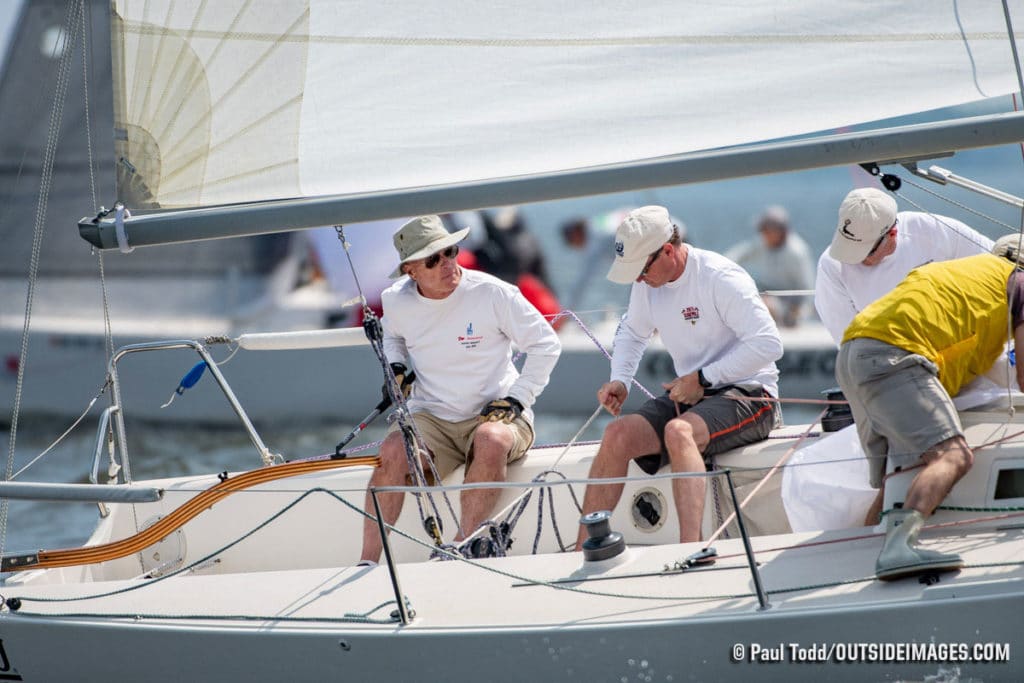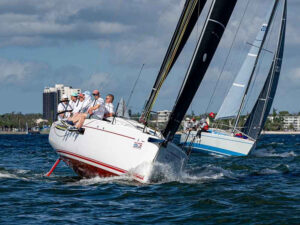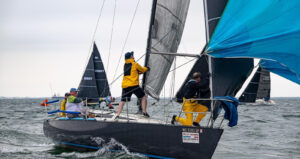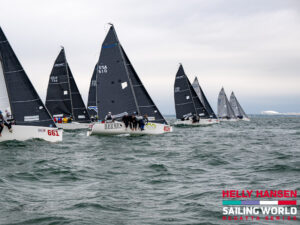So much of the one-design love these days is doted upon the J/70 class, and rightly so, because it really is the biggest thing happening in keelboat sailing. But it’s easy to overlook the influence of the sportboat that preceded it, the 26-footer responsible for introducing a generation of diehard symmetric-spinnaker sailors to asymmetric get-up-and-go sailing.
Stable and less physically demanding to sail than other sportboats of its time, the J/80, and the class, continues to deliver to owners and Corinthian teams that appreciate good racing, straight-forward tuning, and easy ownership. With nearly 1,600 of them sailing worldwide, major championships still draw healthy fleets and top-level teams, and in harbors like Annapolis, J/80 class racing is alive and well since being officially established in 1995.

Rich Harrison, of Annapolis, Maryland, is one owner pulled straight out of the class-adoption textbook. Leaving behind the family J/30, which served as both raceboat and family weekender, he sought a boat that he could simply race with fewer crew. “I wanted something that didn’t require as much crew,” he says. With the J/80, you can sail with three, four, or five, but four is ideal.
The class itself has come on stronger over the last five or six years, adds Harrison. They’re one of the larger fleets at the Helly Hansen NOOD Regatta in Annapolis—behind the J/70 and J/22s – and they’ll routinely have 18 boats for regional weekend regattas. Most owners are plenty active in their respective twilight club series. While Harrison has owned Some Respect for six years, he admits the quest to unlock its secrets remains ongoing. “We’re still searching,” he says. “It does help to have a professional on board, but otherwise, it’s concentration, and for my part, driving and all the nuances that come with it.”
As owner and skipper, Harrison says he’s responsible for setting up the boat and getting the rig just right for the day: “A couple of turns can make a difference between being competitive or not,” he says. “I’m not skilled enough [to feel the subtle differences of rig tune], but I just know I have to have it set up right. Learning the rig is the most important thing to making the boat fast. The foils should be templated so they are where they should be and the hull surface has to be good.”
If he ever gets slow, his longtime crewmates aren’t afraid to let him know, and he especially relies on his son, who Harrison defines as the boat’s “tactician and boatspeed professional.” He’s the one who best keeps him honest. “He brings another dimension that I don’t have,” says Harrison.
It hasn’t been easy for the J/80 class of late, especially with new classes poaching owners and teams, but Harrison says the initial bleeding to the 70s has waned and the J/80 class has managed to backfill its owners list. “We’re as strong as we’ve been in six years,” he says. “Stronger today than when I joined the fleet.”
Newcomers to the class—at least in the Chesapeake, says Harrison — are coming from other less performance-orientated boats. The average age of new owners is somewhere around 50 but there are a few younger. “The boat has a great cockpit so it lends itself to somebody that would not be comfortable in something more high performance, as far as getting around the boat,” he says. “It’s civilized and easy to sail with two for a day sail.”
Atop the local pecking order, says Harrison, is local sailor John White, who consistently sails with good people, including North Sails’ Jonathan Bartlett. “He’s meticulous with boat preparation,” Harrison says of Bartlett, “and I’m sure he wouldn’t find my boat acceptable. He would have to do some serious work to the foils and the hull to make it perfect.”
While he’s happy with the boat he now has, he says, a search for a good used boat will take time and patience, but they’re out there to be found. The market is good for both boat owners and buyers, and while it’s not an excessively expensive boat, 30 to 40 thousand dollars is about right for a race ready boat in need of some improvements. “There are top-tier boats available,” says Harrison, “but you have to dig around for them.”









